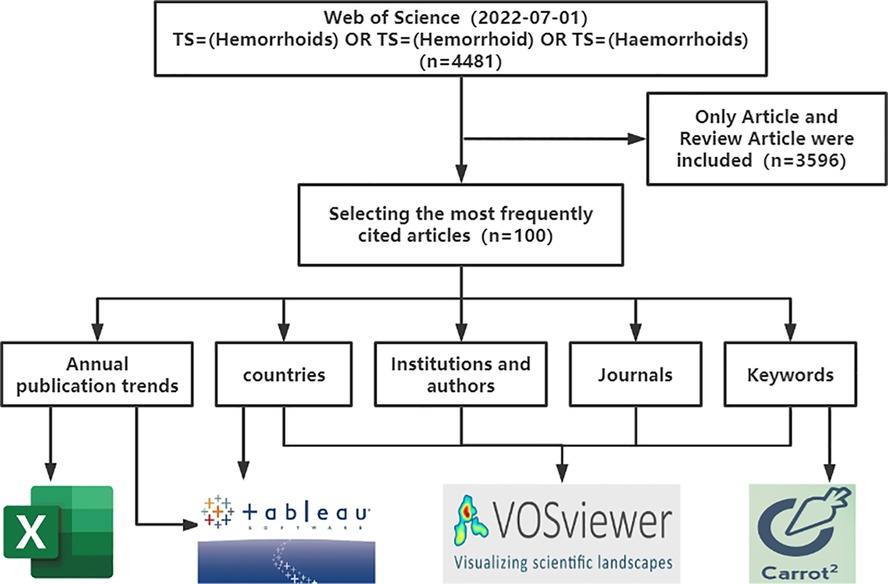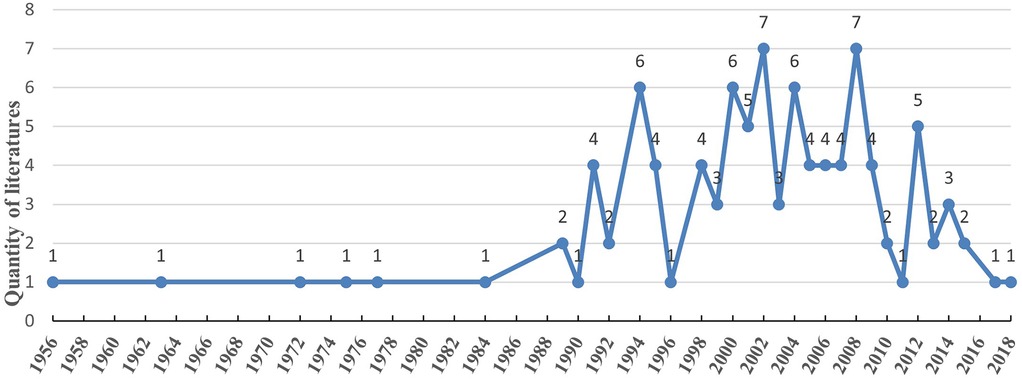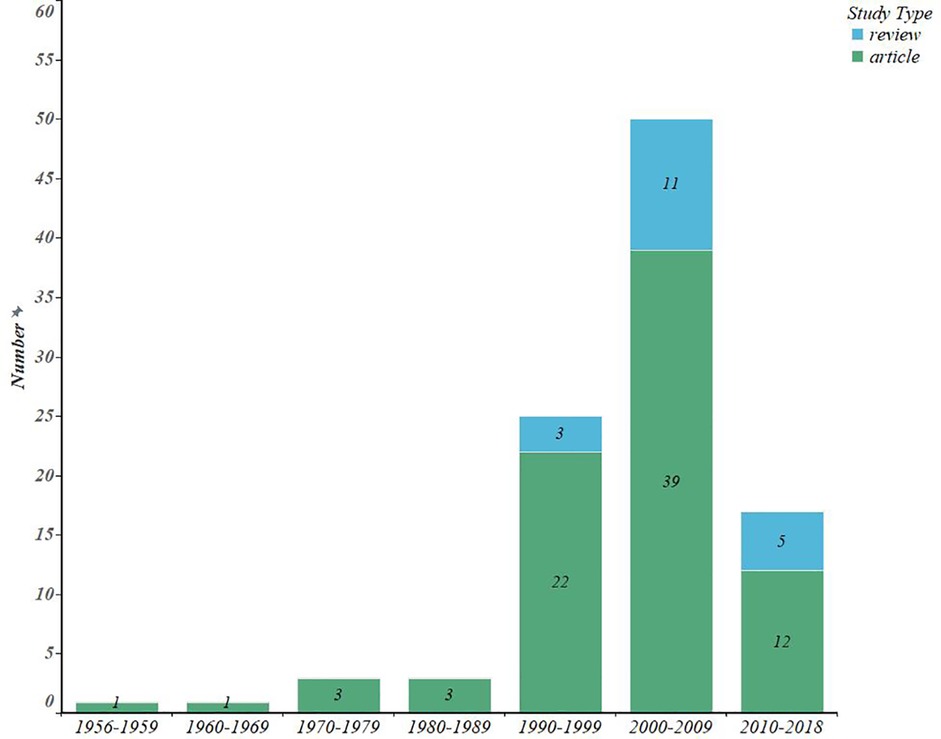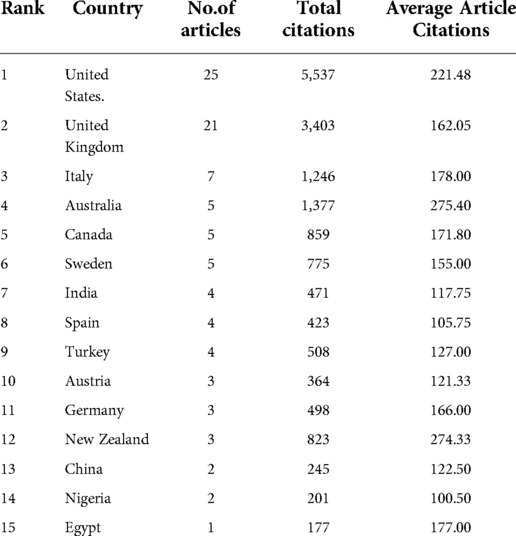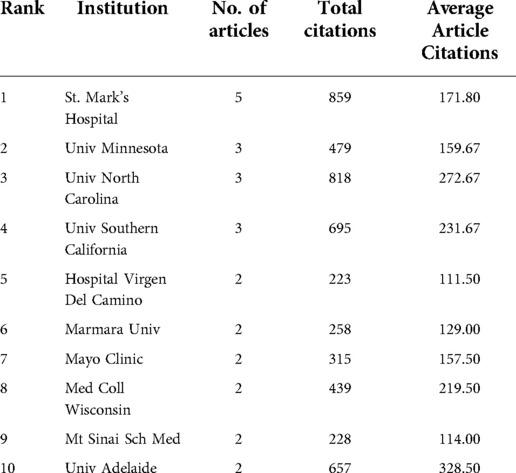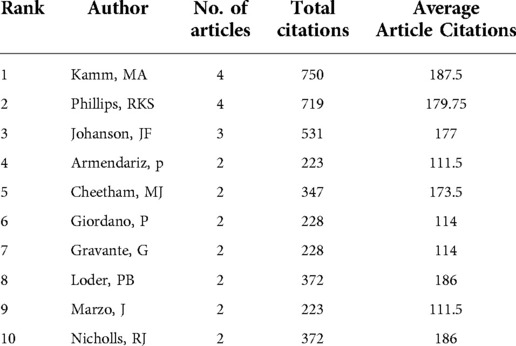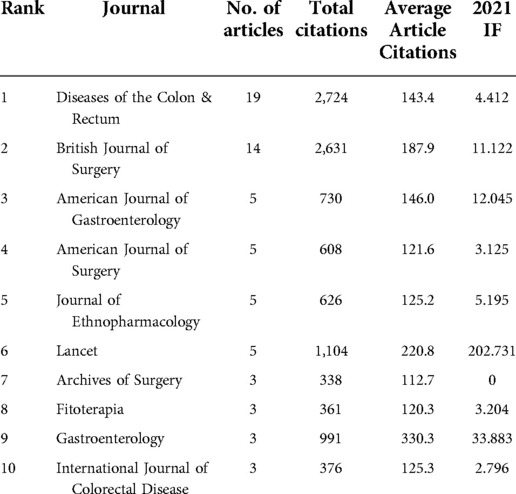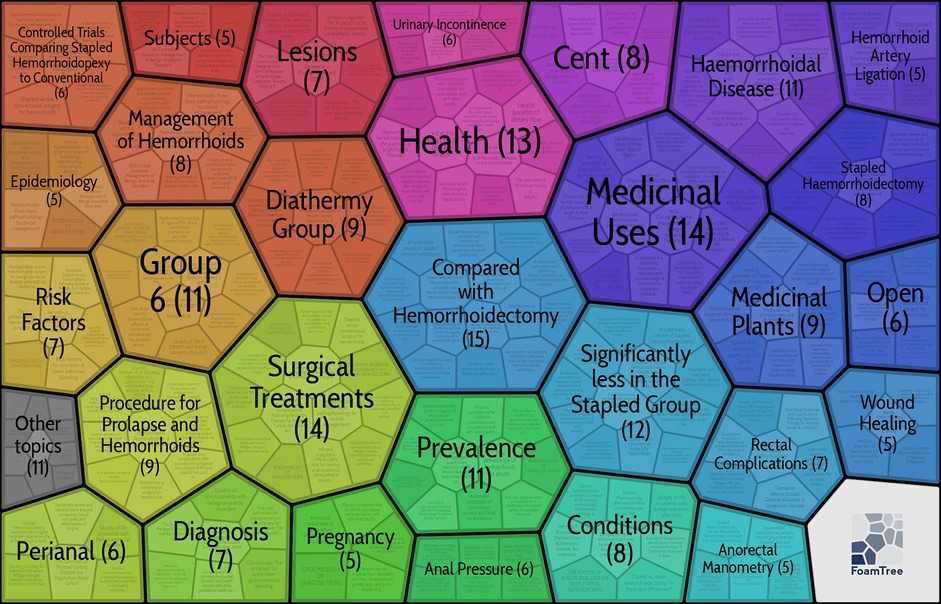Top 100 most-cited articles on hemorrhoids: A bibliometric analysis and visualized study
- Department of Anorectal Surgery, The Affiliated People's Hospital of Fujian University of Traditional Chinese Medicine, Fuzhou, China
Background: Hemorrhoids have a significant incidence in people and are becoming a common public health problem. This study provides a bibliometric and visualized analysis of the most influential literature in the field. The aim is to reveal trends in the field of hemorrhoids and to provide a reference for researchers.
Methods: The 100 most frequently cited studies in the field of hemorrhoids were collected from the Web of Science(WOS), and were analyzed in terms of the annual publication, types of literature, countries, institutions, authors, journals, and keywords. During the study, we used a combination of VosViewer, Carrot2, Microsoft Excel, and Tableau tools to better present the visual information.
Results: A total of 4,481 articles were retrieved, of which 3,592 were of the Article and Review types, among which we selected the 100 most frequently cited. A large amount of highly cited literature on hemorrhoid surgery emerged from 1990 to 2010, and the interest of researchers in hemorrhoid surgery seems to have waned after 2010. The sources of highly cited literature in the field of hemorrhoids are predominantly Western, with the United States. and the United Kingdom accounting for almost half of the publications worldwide. However, countries with higher prevalence populations do not have significant research on hemorrhoids. St. Mark's Hospital has published the largest number of influential articles in the field of hemorrhoid disease. Kamm MA and Phillips RKS are the most authoritative authors in the field. Diseases of the Colon & Rectum and the British Journal of Surgery are the most influential journals in this field. The highly cited literature covers a wide range of disciplines, with Thomson's classic “The nature of hemorrhoids” receiving the most attention among the studies focusing on hemorrhoids. Keyword and clustering analysis revealed that The most famous focus in the field of hemorrhoid research is the evolution of stapled hemorrhoidectomy (SH) and Milligan-morgan hemorrhoidectomy (MMH).
Conclusions: This study is the first to explore developments in the field of hemorrhoids, and it helps surgeons quickly understand global trends in the field of hemorrhoids. In recent years, the development of hemorrhoids seems to have hit a bottleneck, with scholarly interest in the field of waning, especially in surgery Procedures. The theory of inferior anal cushion migration has proven to be the most influential theory in the field, but after studies based on SH and MMH, more high-quality evidence is needed to continue advancing the field of hemorrhoids. The results of this study are intended to add to the attention and interest of scholars in this area and provide a reference for further research.
Introduction
Research shows that more than one-third of people have hemorrhoids that are found during colonoscopy (1–3); however, flexible endoscopy cannot diagnose asymptomatic hemorrhoids (4). This means that hemorrhoids have more potential to develop in the population and are one of the most common diseases in the world.
While the main symptoms of internal hemorrhoids are painless bleeding and intermittent prolapse, thrombosed external hemorrhoids can cause severe pain to the patient (5). Thomson's research in 1975 established the basis for the theory of inferior displacement of the anal cushion, which suggests that hemorrhoids develop due to congestion, hypertrophy, and prolapse of the anal cushion (6). A 2018 guideline suggests that improving diet and lifestyle habits is the first-line therapy for hemorrhoids, while there are many medication options (7). Conservative treatment usually fails, and patients with stage III and IV hemorrhoids can consider surgery. Surgery, outpatient treatment, and medication are effective treatments for hemorrhoids, but clinically they have more classifications and options (7, 8).
Despite the enormous economic burden and distress hemorrhoids cause society, they still receive little attention (9). The lack of understanding of hemorrhoids by many physicians, coupled with the fact that hemorrhoids often have overlapping signs and symptoms with other anorectal conditions, means that hemorrhoids are often incorrectly evaluated (10). In the United States., billions of dollars are spent on hemorrhoid treatment each year, but physician misdiagnosis raises this value (5). Due to a lack of awareness, many cases of overtreatment may occur, or people may severely underestimate the dangers of symptomatic hemorrhoids (9).
Therefore, we explored the field of hemorrhoids for the first time using a bibliometric approach to identify global trends and the knowledge architecture of hemorrhoids. We hope to provide a comprehensive basis for surgeons' research and clinical work and insights into explorations in the field.
Methods
Bibliometric analysis and visualized study
Bibliometric analysis provides a quantitative approach to exploring a specific field to discover the dynamics and progress of a discipline (11–13). A visualized study facilitates the interpretation of data and uncovers the internal connections between them (14). During this study, we used Excel (Version 2021), VOSviewer (Version 1.6.18), Carrot2 (https://search.carrot2.org/#/workbench), and Tableau (Version 2022.2) for the bibliometric analysis and visualization of the literature. In scientific research, the act of citation is meant to endorse or critique the cited literature's results; thus, highly cited literature represents the hot spots of a field of research and the trend carriers of the discipline (15). Therefore, we selected 100 articles of great importance, including the main annual publication trends, type of literature, country, author, institution, publication, co-occurrence of keywords, and cluster analysis.
Search strategy and literature screening
WOS is considered the most worthwhile database for bibliometric analysis because of its high quality (16, 17). We collected literature from the WOS Core Collection from 1900 to 2022, and searched for the date 2022–07–01. In developing the search strategy, we referred to the MeSH subject headings list and some older literature and finally settled on TS = (Hemorrhoids) OR TS = (Hemorrhoid) OR TS = (Haemorrhoids). After the search, we sorted all entries by citation frequency, and only original research articles and reviews were taken into account. Meeting abstract, letter, proceeding paper, and other types of materials will not be considered. Finally, we found the 100 most frequently cited articles. It is important to note that this literature contains several different fields, such as gastroenterology, surgery, and even botany, as we used a subject search, and some of the literature only mentioned hemorrhoids in the abstract and were therefore included in the study. We believe that these articles equally advance the field of hemorrhoids. The collection process of the literature was carried out independently by the two authors, and after that, after which a final agreement was reached through communication. We document the study flow in detail in Figure 1 to provide the reader with a better understanding of our work and to ensure the reproducibility of the study.
Results
Annual publication trends
Through the search, we found 4,481 publications and saved the 100 most cited Article and Review literature. Figure 2 shows that, literature was published from 1956 to 2018, with a low point before 1990, after which the number of publications grew significantly faster, with peaks in 2002 and 2008, with seven publications. However, there were only 15 highly cited publications from 2010 to 2018, and only 1 of them was related to surgery for hemorrhoids. As shown in Figure 3, the number of Articles in the top 100 papers far exceeds that of Reviews, and most of the two literature types are primarily concentrated in 2000–2009. Table 1 records the ten most influential publications, and we found that Anderson's 2009 article was cited much more often than the other 9.
Countries
We use the algorithm that comes with VOSviewer for country publication measurement to ensure the most accurate statistics are obtained. The country statistics using VOSviewer takes into account all authors, but if multiple authors in 1 article are from the same country, only one count is performed. We merged Scotland into the UK, so 30 countries were involved in publishing highly cited literature. Figure 4A shows the geographical visualization between countries, and we find that they are primarily coastal. Table 2 records the 15 countries with the highest number of publications, with the United States. (n = 25) and the UK (n = 21) having nearly the same number of highly cited articles as the other countries combined. The average number of citations for publications from Australia, New Zealand, and the United States is significant, at 275.4, 274.3, and 221.5, respectively, indicating that some of their articles are highly influential. Figure 4B shows a lack of cooperation between countries, mainly concentrated among developed Western countries.
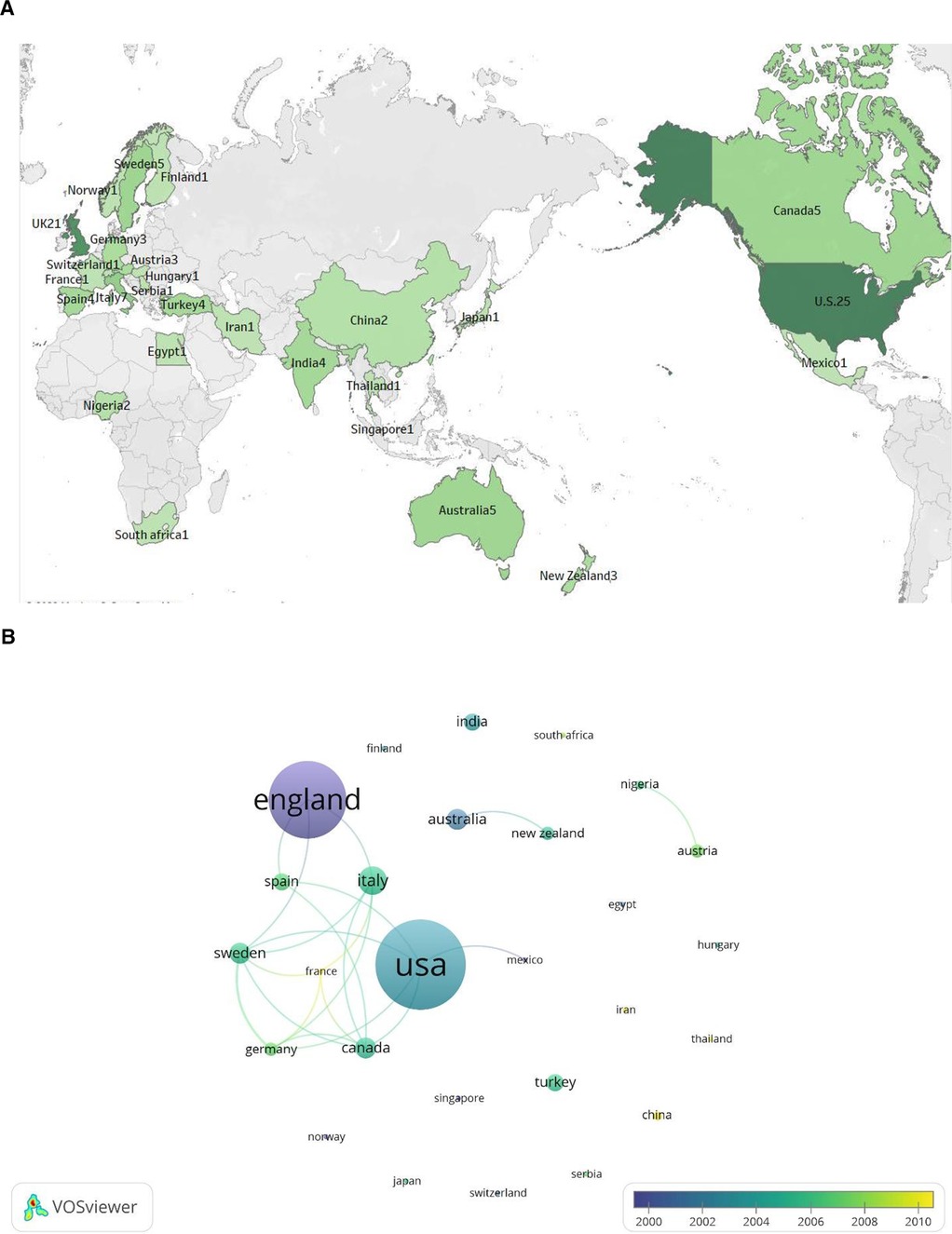
Figure 4. Countries of publication of the top 100 most-cited articles. (A) Geographical visualization of national publications, (B) Countries’ cooperation coexistence diagram.
Institutions and authors
A total of 163 institutions were involved in publishing highly cited literature, and the top 10 most cited institutions are recorded in Table 3. The institution with the most publications is St. Mark's Hospital (n = 5) in the UK, followed by the University of Minnesota (n = 3), the University of North Carolina (n = 3), and the University of Southern California (n = 3), all in the United States. The partnership between the institutions can be seen in Figure 5A, which shows that St. Mark's Hospital has an early start and a significant number of high-value publications. As shown in Table 4, a total of 393 authors participated in the highly cited literature, with Kamm MA (n = 4), and Phillips RKS (n = 4) publishing the most articles, and the remaining authors all publishing only 1–2 influential papers each in the field of hemorrhoids. The collaborative relationship between the authors is shown in Figure 5B.
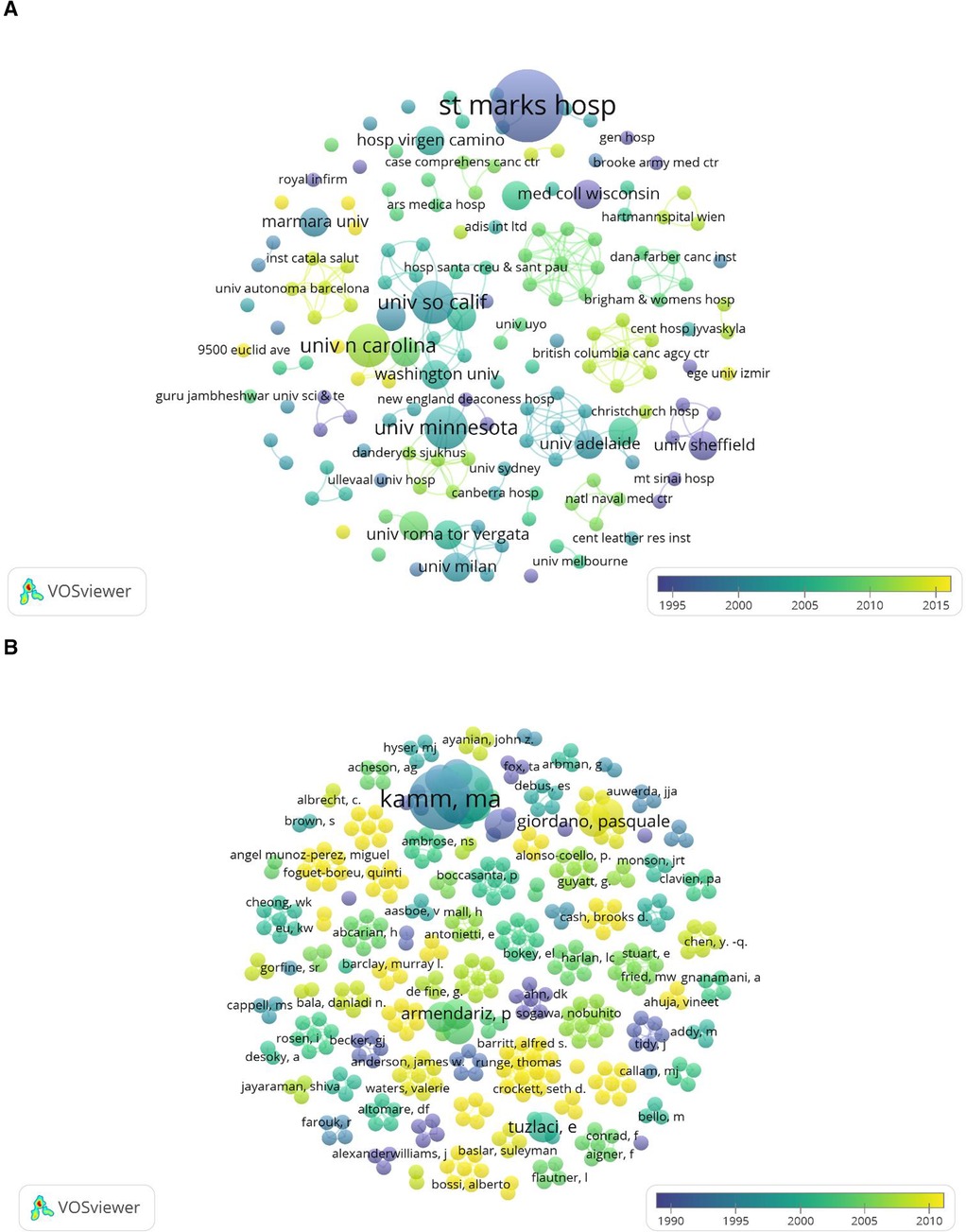
Figure 5. Publication status of authors and institutions of the 100 most-cited articles. (A) Institutions’ cooperation coexistence diagram, (B) authors’ cooperation coexistence diagram.
Journals
The 100 most cited studies on hemorrhoids were published in 42 journals, and Table 5 records the ten most published journals, along with their citation frequency, impact factor, and division. Among them, Diseases of the Colon & Rectum (n = 19) ranked first, followed by the British Journal of Surgery (n = 14) and the American Journal of Gastroenterology (n = 5), among others. This information will help inform the dissemination of articles in this area. Although there are few publications in Lancet and Gastroenterology, their average article citations are 220.8 and 330.3, respectively, but this does not explain the correlation between the impact factor and the number of citations.
Keywords
We performed a co-occurrence network analysis of keywords extracted from 100 documents to identify the most important keywords and their relationships. We set the keyword threshold to “3”, cleaned the data of keywords with the same meaning, and ticked to hide the keywords of “hemorrhoids,” “disease,” and “expression” with little meaning. As shown in Figure 6A, the size of each node depends on the number of keyword occurrences, the color represents the average year of keyword occurrences, and the connecting line represents two keywords appearing together in the literature.
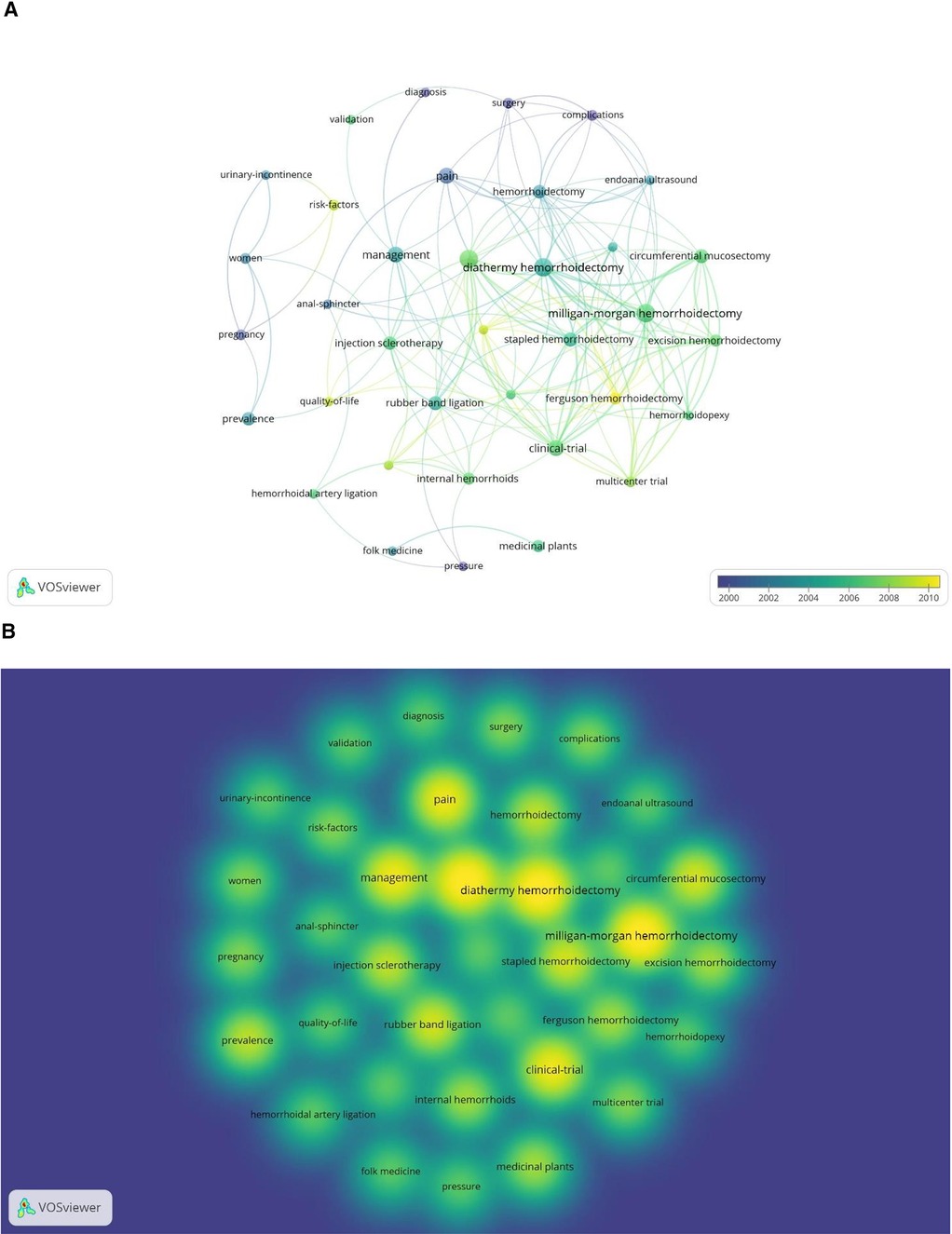
Figure 6. Network chart of keywords of the 100 most-cited articles. (A) Keyword co-occurrence chart, (B) Keyword heat diagram.
We found that “pregnancy,” “pressure,” “surgery,” “diagnosis,” and “complications” were the early keywords, suggesting that the early focus of researchers was on the onset of hemorrhoids, diagnosis, anal pressure, and the impact of surgery on complications. “Ferguson hemorrhoidectomy,”(FH) “quality of life,” “risk factors,” and “multicenter trial” are newer keywords in the figure, suggesting that researchers may henceforth focus more on high-quality randomized controlled trials, surgical modalities, and their prognosis. Numerous keywords on hemorrhoid treatment were focused on in 2006–2008, including “conventional hemorrhoidectomy,” (CH) “diathermy hemorrhoidectomy,”(DH) “excision hemorrhoidectomy,”(EH) “SH,” “MMH,” “injection sclerotherapy,” “hemorrhoidal artery ligation,” and “medicinal plants,” thus indicating that this period was a peak in the development of hemorrhoid disease, with the addition of evidence for many treatments driving the research the boom.
Figure 6B shows the visualization of keyword hotness, from which we can see that “MMH,” “DH”, “clinical-trial, “management,” and “pain” are the most popular keywords. These represent the most popular topics in the field of hemorrhoids. “Circumferential mucosectomy,” “rubber band ligation,” and “injection sclerotherapy” followed in popularity as the more common surgical treatments for hemorrhoids. To obtain satisfactory clustering results, we used Carrot2 to cluster the keywords of the highly cited literature on hemorrhoid disease. From Figure 7, the most important clusters are “Compared with Hemorrhoidectomy” and “Surgical Treatments,” followed by “Medicinal Uses.”
Discussion
Shneider A defines the development of disciplines as taking place in four stages: introducing new problems, the birth of research tools, the generation of disciplinary knowledge based on tools, and the transfer of knowledge and methods (18). Even though hemorrhoids are one of the most common diseases in the world, no scholars have used bibliometric tools to uncover knowledge in the field of hemorrhoids until now. A well-established field needs extensive citation literature to support it. Although a discussion of only the highly cited literature is not representative of the field as a whole, it gives us an idea of the most influential historical contributions and the directions scholars are most concerned with (19), and reduces the redundancy generated by large samples of data.
The amount of highly cited literature was low until 1990, after which it began to increase irregularly until after 2010 when scholarly interest in the field seems to have decreased again. However, some new articles in recent years may be of significant value but have been published for a relatively short period of time and therefore have not been widely cited. This may also be one of the reasons.
The number of highly cited studies in the United States. and the United Kingdom is almost equal to that of the other countries combined, especially since most institutions with many publications are from the United States. Hemorrhoids are a disease of all humans, and the fact that most of the highly cited literature comes from Western countries may be related to economic and scientific strength, not that hemorrhoids are widespread only in Western countries. For example, Asian countries such as Israel and South Korea and African countries such as Ethiopia alomst have the highest hemorrhoid rates globally, which is unbalanced (20–22). Some cooperation exists between western countries, but academic exchanges are still lacking in most other countries. The public has become aware of the economic and work day burden that hemorrhoids place on health systems (9, 23), so we are calling on researchers to increase their attention to hemorrhoids, especially in countries whose population is that are deeply affected by hemorrhoids.
The most frequently cited article is Anderson 2009, which found that high levels of dietary fiber reduce the prevalence of hemorrhoids (24). The first ten articles also included three epidemiological reports: MacLennan 2000 concluded that hemorrhoid symptoms were positively correlated with age and fecundity (25), Peery 2015 found 4 million cases of hemorrhoids annually, accounting for the third highest number of outpatient diagnoses of gastrointestinal, liver, and pancreatic diseases in the United States (26), and Johanson 1990 found that hemorrhoids and constipation did not have a significant causal relationship (27). Unfortunately, none of the five most cited articles had hemorrhoids as a significant research target, so the most influential article in the field of hemorrhoids was Tomshen 1975 (5), which suggests that the doctrine of inferior anal cushion migration, based on this article, has the greatest influence in the current field of hemorrhoids. Also, the most popular studies were Mehigan 2000 and Macrae 1995, who compared different treatments for hemorrhoids (28, 29).
Kamm MA (n = 4), and Phillips RKS (n = 4), published the most highly cited papers in the field of hemorrhoid disease, with their studies published from 1991 to 2003. The main topics include a comparison of the efficacy of SH and DH (30, 31), the pathogenesis of hemorrhoids (32), and the effect of anal dilation on the anal sphincter (33). It was followed by Johanson JF (n = 3), whose studies were published from 1990 to 2006 and included: an epidemiological comparison of hemorrhoids and constipation (27), and nonsurgical treatment of hemorrhoids (34, 35). “MMH,” “DH,” and “RCT” are the most frequent keywords. MMH and DH are regarded as the same traditional hemorrhoid surgery (36), a classic procedure derived from the “Milligan” and “Morgan” of St. Mark's Hospital in the UK in 1937 (37), which was considered the gold standard for hemorrhoid surgery in the past (38). We read Citations Citing Articles to identify those keywords, and most of them are related to SH (39–41), a surgical method proposed by Longo in 1998 (42), which is also called the Procedure for Prolapse and Hemorrhoids (43), and was sometimes considered an alternative to conventional MMH (40). This can explain the second increase in the emergence of highly cited literature after 1998, implying that the impact of new surgical modalities was yielding important scientific results. We found that the comparison between SH and MMH is almost the most significant focus in the field of hemorrhoids because they are controversial, with the anastomosis procedure reducing short-term pain in patients but with problems of stool urgency and high recurrence rates in long-term follow up (44–46), so some scholars consider that MMH remains the gold standard for hemorrhoid surgery (38, 47). We found many articles on hemorrhoid surgery appearing between 1988 and 2010, but of the 15 highly cited literature after 2010, only one was related to the surgery of hemorrhoids (48). This study summarizes and updates the previous Meta-analysis for comparing 11 surgical procedures for grade III and IV hemorrhoids. The highly cited literature after 2010 includes epidemiology and guidelines for hemorrhoids and also relates to pharmacology and gastroenterology. This implies that although the comparison of SH with MMH remains the most important part of the field as a whole, the development of procedures related to hemorrhoids after 2010 may have reached a bottleneck, leading to a waning of scholarly interest in the disease. Therefore, we believe that an update of the procedures and further cross-collaboration between hemorrhoids and other fields may be the key to the revitalization of the field again. In addition, we noted some high-frequency secondary keywords: “rubber band ligation” and “injection sclerotherapy.” Bleday found that 44.8% of patients underwent rubber band ligation in 1985, and 0.7% underwent injection sclerotherapy in 1990 (49). The 2018 ASCRS guidelines strongly recommend that they are a treatment option for grades I, II, and III hemorrhoids if pharmacologic therapy fails (7), but infrared coagulation did not appear in our high-frequency keywords.
We clustered the snippet and title of the document using the Lingo algorithm based on singular value decomposition. The Lingo algorithm, proposed by Osiński S (50), differs from traditional STC clustering algorithms in that it produces many small clusters and places great emphasis on the descriptive quality of the clusters. We performed a cluster analysis of these keywords to help identify some standard labels in the literature with similar characteristics and reveal hotspots (51, 52). The two most significant clusters reiterate the focus in the field of hemorrhoids. In addition to SH and MMH, surgical modalities such as FH and Transanal hemorrhoidal dearterialization(THD) are included (48, 53). The third central cluster, Medicinal Uses, mentions many medicinal plants for hemorrhoids (54, 55), and although this literature is rarely referenced in the field of hemorrhoids, it may provide fruitful directions.
Limitation
We have carefully considered the study's limitations and, therefore, need to describe our results more objectively. First, we designed this study to ensure the quality and integrity of the literature and to reduce the production of duplicate data by only selecting data from WOS, which, despite being the most prestigious database in the world, may still miss some studies. Second, the analysis of only the highly cited literature is not representative of the entire field; some new research has an impact, but citation frequency is a cumulative process. Third, unlike classification, clustering algorithms are a form of unsupervised deep learning, and although the computer uses the Lingo algorithm, which produces more easily decipherable clustering labels, there are still some labels whose meaning is unclear, and we usually need to focus only on the most important clusters.
Conclusion
This study is the first bibliometric analysis of the field of hemorrhoids. Our findings suggest that despite the significant increase in highly cited literature on hemorrhoids after 1990, scholarly interest has waned significantly after 2010, especially as the highly cited literature on hemorrhoid surgery is very sparse. This does not mean that the field is no longer essential to explore, as there are some new social burdens. In addition, excellence is necessary for the development of surgery. The volume of highly cited literature in the United States. and the United Kingdom is almost equal to that of other countries combined, so more research efforts are needed to advance the field of hemorrhoid disease. Our study reveals global trends in hemorrhoid disease, with the doctrine of inferior anal cushion migration having the greatest impact on the development of hemorrhoids, and the comparison of SH and MMH is probably the most popular focus in the field, meaning that the emergence of new surgical modalities will cause dramatic changes. Researchers can quickly learn about the field through the evolution of related procedures, for example, by looking for hot spots in the latest surgical approaches, leading to more collaborations.
Data availability statement
The original contributions presented in the study are included in the article/Supplementary Material, further inquiries can be directed to the corresponding author/s.
Author contributions
RS proposed and designed the study. YL and XW collected database information. ZW and JH ran the software processed the figures and tables. ZW wrote the first draft, and JW revised the language and article content. All authors contributed to the article and approved the submitted version.
Funding
The research was funded by the National Natural Science Foundation of China (Nos. 81973852) and the Natural Science Foundation of Fujian Province (Nos. 2020Y01010177).
Acknowledgment
We thank the editor and reviewers for their time and effort, and for their insightful comments and valuable improvements to the paper. We also thank Professors RS and JW for their guidance.
Conflict of interest
The authors declare that the research was conducted in the absence of any commercial or financial relationships that could be construed as a potential conflict of interest.
Publisher's note
All claims expressed in this article are solely those of the authors and do not necessarily represent those of their affiliated organizations, or those of the publisher, the editors and the reviewers. Any product that may be evaluated in this article, or claim that may be made by its manufacturer, is not guaranteed or endorsed by the publisher.
References
1. Everhart JE, Ruhl CE. Burden of digestive diseases in the United States part II: lower gastrointestinal diseases. Gastroenterol. (2009) 136:741–54. doi: 10.1053/j.gastro.2009.01.015
2. Kante B, Vuyyuru SK, Gupta R, Dwivedi T, Kumar P, Mundhra S, et al. Similar risk of infection with SARS-CoV-2 in immunocompromised and immunocompetent patients with inflammatory bowel disease and healthy controls. J Crohns Colitis. (2022) 161:I614–5. doi: 10.1093/ecco-jcc/jjab232.841
3. Riss S, Weiser FA, Riss T, Schwameis K, Mittlboeck M, Stift A. Haemorrhoids and quality of life. Colorectal Dis. (2011) 13:E48–52. doi: 10.1111/j.1463-1318.2010.02480.x
4. Wald A, Bharucha AE, Cosman BC, Whitehead WE. ACG Clinical guideline: management of benign anorectal disorders. Am J Gastroenterol. (2014) 109:1141–57. doi: 10.1038/ajg.2014.190
5. Cosman BC. Piles of money: “hemorrhoids” are a billion-dollar industry. Am J Gastroenterol. (2019) 114:716–7. doi: 10.14309/ajg.0000000000000234
7. Davis BR, Lee-Kong SA, Migaly J, Feingold DL, Steele SR. The American society of colon and rectal surgeons clinical practice guidelines for the management of hemorrhoids. Dis Colon Rectum. (2018) 61:284–92. doi: 10.1097/DCR.0000000000001030
9. Sandler RS, Peery AF. Rethinking what we know about hemorrhoids. Clin Gastroenterol H. (2019) 17:8–15. doi: 10.1016/j.cgh.2018.03.020
10. Idrees JJ, Clapp M, Brady JT, Stein SL, Reynolds HL, Steinhagen E. Evaluating the accuracy of hemorrhoids: comparison among specialties and symptoms. Dis Colon Rectum. (2019) 62:867–71. doi: 10.1097/DCR.0000000000001315
11. van Raan A. Measuring science: basic principles and application of advanced bibliometrics. In: Glänzel W, editor. Springer Handbooks book series (SHB). Cham, Springer (2019). p. 237–80.
12. Mayr P, Scharnhorst A. Scientometrics and information retrieval: weak-links revitalized. Scientometrics. (2015) 102:2193–9. doi: 10.1007/s11192-014-1484-3
13. Gan P, Fan W, Zhang H, Zhong C, Xia H, Lue M, et al. The top-cited articles with a focus on barrett's Esophagus: a bibliometric analysis. Front Surg. (2022) 9:743274. doi: 10.3389/fsurg.2022.743274
14. Huang F, Zheng B, Wu C, Zhao S, Xu Y, Li Z, et al. International publication trends in low back pain research: a bibliometric and visualization analysis. Front Public Health. (2022) 10:746591. doi: 10.3389/fpubh.2022.746591
15. Liu Y, Rousseau R. Interestingness and the essence of citation. J Doc. (2013) 69:580–9. doi: 10.1108/JD-07-2012-0082
16. Ding X, Yang Z. Knowledge mapping of platform research: a visual analysis using VOSviewer and CiteSpace. Electron Commer Res. (2020) 22:787–809. doi: 10.1007/s10660-020-09410-7
17. Aggarwal A, Lewison G, Idir S, Peters M, Aldige C, Boerckel W, et al. The state of lung cancer research: a global analysis. J Thorac Oncol. (2016) 11:1040–50. doi: 10.1016/j.jtho.2016.03.010
18. Shneider AM. Four stages of a scientific discipline; four types of scientist. Trends Biochem Sci. (2009) 34:217–23. doi: 10.1016/j.tibs.2009.02.002
19. Donnally CJ III, Lugo-Pico JG, Bondar KJ, Chen CJ, McCormick JR, Errico TJ. Characteristics and trends of the most cited spine publications. Spine. (2021) 46:765–71. doi: 10.1097/BRS.0000000000003890
20. Kibret AA, Oumer M, Moges AM. Prevalence and associated factors of hemorrhoids among adult patients visiting the surgical outpatient department in the university of gondar comprehensive specialized hospital, northwest Ethiopia. Plos One. (2021) 16:e249736. doi: 10.1371/journal.pone.0249736
21. Carter D, Carter D, Gabel MB, Zbar A, Segev S, Kopylov U. Prevalence and clinical associations of hemorrhoids at screening colonoscopy. World J Colorectal Surg. (2013) 3:1–15.
22. Hong J, Kim I, Song J, Ahn BK. Socio-demographic factors and lifestyle associated with symptomatic hemorrhoids: big data analysis using the national health insurance service-national health screening cohort (NHIS-HEALS) database in Korea. Asian J Surg. (2022) 45:353–9. doi: 10.1016/j.asjsur.2021.06.020
23. Rubbini M, Ascanelli S, Fabbian F. Hemorrhoidal disease: is it time for a new classification? Int J Colorectal Dis. (2018) 33:831–3. doi: 10.1007/s00384-018-3060-4
24. Anderson JW, Baird P Jr, Davis RH, Ferreri S, Knudtson M, Koraym A, et al. Health benefits of dietary fiber. Nutr Rev. (2009) 67:188–205. doi: 10.1111/j.1753-4887.2009.00189.x
25. MacLennan AH, Taylor AW, Wilson DH, Wilson D. The prevalence of pelvic floor disorders and their relationship to gender, age, parity and mode of delivery. Br J Obstet Gynaecol. (2000) 107:1460–70. doi: 10.1111/j.1471-0528.2000.tb11669.x
26. Peery AF, Crockett SD, Barritt AS, Dellon ES, Eluri S, Gangarosa LM, et al. Burden of gastrointestinal, liver, and pancreatic diseases in the United States. Gastroenterol. (2015) 149:1731. doi: 10.1053/j.gastro.2015.08.045
27. Johanson JF, Sonnenberg A. The prevalence of hemorrhoids and chronic constipation - an epidemiologic-study. Gastroenterol. (1990) 98:380–6. doi: 10.1016/0016-5085(90)90828-O
28. Mehigan BJ, Monson J, Hartley JE. Stapling procedure for haemorrhoids versus milligan-morgan haemorrhoidectomy: randomised controlled trial. Lancet. (2000) 355:782–5. doi: 10.1016/S0140-6736(99)08362-2
29. Macrae HM, Mcleod RS. Comparison of hemorrhoidal treatment modalities - a metaanalysis. Dis Colon Rectum. (1995) 38:687–94. doi: 10.1007/BF02048023
30. Cheetham MJ, Mortensen N, Nystrom PO, Kamm MA, Phillips R. Persistent pain and faecal urgency after stapled haemorrhoidectomy. Lancet. (2000) 356:730–3. doi: 10.1016/S0140-6736(00)02632-5
31. Cheetham MJ, Cohen C, Kamm AA, Phillips R. A randomized, controlled trial of diathermy hemorrhoidectomy vs. Stapled hemorrhoidectomy in an intended day-care setting with longer-term follow-up. Dis Colon Rectum. (2003) 46:491–7. doi: 10.1007/s10350-004-6588-z
32. Loder PB, Kamm MA, Nicholls RJ, Phillips R. Hemorrhoids - pathology, pathophysiology and etiology. Br J Surg. (1994) 81:946–54. doi: 10.1002/bjs.1800810707
33. Speakman C, Burnett S, Kamm MA, Bartram CI. Sphincter injury after anal dilatation demonstrated by anal endosonography. Br J Surg. (1991) 78:1429–30. doi: 10.1002/bjs.1800781206
34. Alonso-Coello P, Zhou Q, Martinez-Zapata MJ, Mills E, Heels-Ansdell D, Johanson JF, et al. Meta-analysis of flavonoids for the treatment of haemorrhoids. Br J Surg. (2006) 93:909–20. doi: 10.1002/bjs.5378
35. Johanson JF, Rimm A. Optimal nonsurgical treatment of hemorrhoids: a comparative analysis of infrared coagulation, rubber band ligation, and injection sclerotherapy. Am J Gastroenterol. (1992) 87:1600–6.1442682
36. Rowsell M, Bello M, Hemingway DM. Circumferential mucosectomy (stapled haemorrhoidectomy) versus conventional haemorrhoidectomy: randomised controlled trial. Lancet. (2000) 355:779–81. doi: 10.1016/S0140-6736(99)06122-X
37. Milligan ET, Morgan CN, Jones LE, Officer R. Surgical anatomy of the anal canal, and the operative treatment of hmorrhoids. Lancet. (1937) 2:119–24. doi: 10.1016/S0140-6736(00)88465-2
38. Nisar PJ, Acheson AG, Neal KR, Scholefield JH. Stapled hemorrhoidopexy compared with conventional hemorrhoidectomy: systematic review of randomized, controlled trials. Dis Colon Rectum. (2004) 47:1837–45. doi: 10.1007/s10350-004-0679-8
39. Kairaluoma M, Nuorva K, Kellokumpu I. Day-case stapled (circular) vs. Diathermy hemorrhoidectomy - a randomized, controlled trial evaluating surgical and functional outcome. Dis Colon Rectum. (2003) 46:93–9. doi: 10.1007/s10350-004-6502-8
40. Lumb KJ, Colquhoun PH, Malthaner R, Jayaraman S. Stapled versus conventional surgery for hemorrhoids. Cochrane Database Syst Rev. (2006) 4:D5393. doi: 10.1002/14651858.CD005393.pub2
41. Tjandra JJ, Chan MKY. Systematic review on the procedure for prolapse and hemorrhoids (stapled hemorrhoidopexy). Dis Colon Rectum. (2007) 50:878–92. doi: 10.1007/s10350-006-0852-3
42. Longo A. Treatment of hemorrhoids disease by reduction of mucosa and hemorrhoidal prolapse with a circular suturing device: a new procedure. EAES 1998: Proceedings of the 6th world congresa of endoscopic surgery. Italy: Rome. p. 777–84.
43. Pescatori M, Gagliardi G. Postoperative complications after procedure for prolapsed hemorrhoids (PPH) and stapled transanal rectal resection (STARR) procedures. Tech Coloproctol. (2008) 12:7–19. doi: 10.1007/s10151-008-0391-0
44. Ganio E, Altomare DF, Gabrielli F, Milito G, Canuti S. Prospective randomized multicentre trial comparing stapled with open haemorrhoidectomy. Br J Surg. (2001) 88:669–74. doi: 10.1046/j.0007-1323.2001.01772.x
45. Shao WJ, Li GH, Zhang ZH, Yang BL, Sun GD, Chen YQ. Systematic review and meta-analysis of randomized controlled trials comparing stapled haemorrhoidopexy with conventional haemorrhoidectomy. Br J Surg. (2008) 95:147–60. doi: 10.1002/bjs.6078
46. Gallo G, Martellucci J, Sturiale A, Clerico G, Milito G, Marino F, et al. Consensus statement of the Italian society of colorectal surgery (SICCR): management and treatment of hemorrhoidal disease. Tech Coloproctol. (2020) 24:145–64. doi: 10.1007/s10151-020-02149-1
47. Gallo G, Realis Luc A, Clerico G, Trompetto M. Diathermy excisional haemorrhoidectomy - still the gold standard - a video vignette. Colorectal Dis. (2018) 20:1154–6. doi: 10.1111/codi.14430
48. Simillis C, Thoukididou SN, Slesser AAP, Rasheed S, Tan E, Tekkis PP. Systematic review and network meta-analysis comparing clinical outcomes and effectiveness of surgical treatments for haemorrhoids. Br J Surg. (2015) 102(13):1603–18. doi: 10.1002/bjs.9913
49. Bleday R, Pena JP, Rothenberger DA, Goldberg SM, Buls JG. Symptomatic hemorrhoids - current incidence and complications of operative therapy. Dis Colon Rectum. (1992) 35:477–81. doi: 10.1007/BF02049406
50. Osiński S, Stefanowski J, Weiss D. Lingo: Search results clustering algorithm based on singular value decomposition[M]//intelligent information processing and web mining. Heidelberg: Springer, Berlin (2004). 359–68.
51. Zheng Z, Xu W, Xue Q. Research hotspots and trends analysis of patellar instability: a bibliometric analysis from 2001 to 2021. Front Surg. (2022) 9:870781. doi: 10.3389/fsurg.2022.870781
52. Chen C, Anjuan FI, Hou J. The structure and dynamics of cocitation clusters: a multiple erspective cocitation analysis. J Am Soc Inf Sci Technol. (2010) 61:1386–409. doi: 10.1002/asi.21309
53. Senagore AJ, Singer M, Abcarian HEA, Fleshman J, Corman M, Wexner S, et al. A prospective, randomized, controlled multicenter trial comparing stapled hemorrhoidopexy and ferguson hemorrhoidectomy: perioperative and one-year results. Dis Colon Rectum. (2004) 47:1824–36. doi: 10.1007/s10350-004-0694-9
54. He X, Wang X, Fang J, Zhao Z, Huang L, Guo H, et al. Bletilla striata: medicinal uses, phytochemistry and pharmacological activities. J Ethnopharmacol. (2017) 195:20–38. doi: 10.1016/j.jep.2016.11.026
Keywords: bibliometric, visualized study, hemorrhoids, Milligan-morgan hemorrhoidectomy, stapled hemorrhoidectomy
Citation: Wang Z, Wu X, Li Y, Huang J, Shi R and Wang J (2022) Top 100 most-cited articles on hemorrhoids: A bibliometric analysis and visualized study. Front. Surg. 9:1021534. doi: 10.3389/fsurg.2022.1021534
Received: 17 August 2022; Accepted: 24 October 2022;
Published: 11 November 2022.
Edited by:
Ibrahim Ethem Gecim, Ankara University, TurkeyReviewed by:
Cihangir Akyol, Ankara University, TurkeyAndy Wai Kan Yeung, University of Hong Kong, China
© 2022 Wang, Wu, Li, Huang, Shi and Wang. This is an open-access article distributed under the terms of the Creative Commons Attribution License (CC BY). The use, distribution or reproduction in other forums is permitted, provided the original author(s) and the copyright owner(s) are credited and that the original publication in this journal is cited, in accordance with accepted academic practice. No use, distribution or reproduction is permitted which does not comply with these terms.
*Correspondence: Rong Shi 13509393654@139.com Jing Wang antcity@126.com
Specialty Section: This article was submitted to Vascular Surgery, a section of the journal Frontiers in Surgery
 Zhaochu Wang
Zhaochu Wang Xuxiong Wu
Xuxiong Wu 